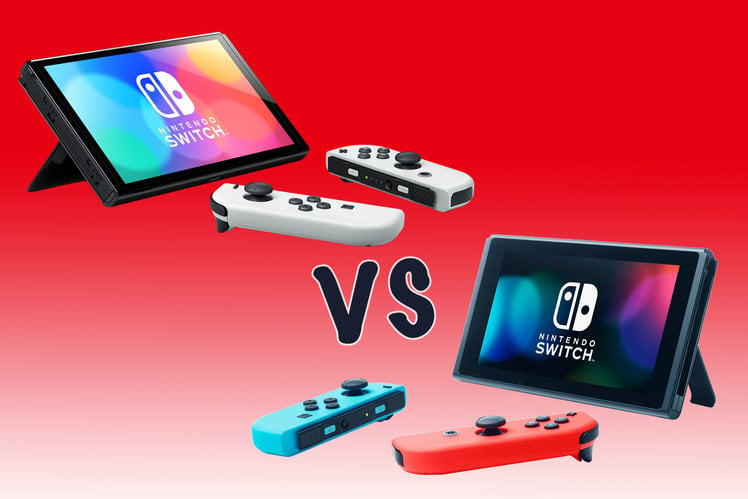
Nintendo put more that a year’s worth of speculation to bed when it announced a new version of the Nintendo Switch in July.
Available from 8 October 2021 and called Nintendo Switch (OLED model), it adds a few new features, not least an eponymous OLED display.
It’ll be more expensive than the existing version and there are no plans to withdraw that one from sale. So, alongside the Switch Lite, there will be three models available for those looking for a new Switch.
Here we look at the Switch and the Switch OLED to help you make that decision.
What’s the same?
- Both work in handheld and TV modes
- 720p60 (handheld), 1080p60 (TV)
- Same processor: custom version of Nvidia Tegra X1
The Nintendo Switch OLED has a number of new features but is essentially the same as the existing Switch on the inside.
Both come with the exact same processing unit – a custom version of the Nvidia Tegra X1 – plus 4GB of RAM. They also each share similar screen specs, with a 720p60 resolution in handheld mode, 1080p60 when docked and plugged into a TV.
This effectively means that all the same Nintendo Switch games work across both consoles. Accessories (Joy-Cons) too, as the size of each of them is similar.
Both come with a dock, two Joy-Con controllers, and a Joy-Con grip to turn them into a more conventional gamepad.
Sadly (and weirdly), the Switch OLED continues the lack of Bluetooth connectivity for headphones.
What’s different?
There are a few key differences between the Nintendo Switch (OLED model) and original Switch.
Size and weight
- Nintendo Switch dimensions: 102 x 239 x 13.9mm (with Joy-Cons attached)
- Nintendo Switch weight: 297g (398g with Joy-Cons)
- Nintendo Switch (OLED model) dimensions: 102 x 242 x 13.9mm (with Joy-Cons attached)
- Nintendo Switch (OLED model) weight: 320g (420g with Joy-Cons)
In terms of size and weight, there is little between them, even though the Switch OLED has a larger display.
It is fractionaliy longer and heavier but you really won’t notice the difference.
Display
- Nintendo Switch: 6.2-inch LCD display
- Nintendo Switch (OLED model): 7-inch OLED display
By far and away the biggest difference betweem the models, both figuratively and literally, is the display.
As the newer console’s name suggests, it now sports an OLED panel which provides better colour accuracy, higher contrast and overall better picture performance. It also has a wider viewing angle in comparison to the LCD panel used in the standard Switch.
Thanks to the lack of a backlight (OLED pixels are self-illuminating), the screen doesn’t require as large a bezel. That means the Switch OLED comes with a 7-inch display without increasing the size of the console itself. The standard Switch screen is 6.2-inches.
Storage
- Nintendo Switch: 32GB on-board storage, microSD card slot for expansion
- Nintendo Switch (OLED model): 64GB on-board storage, microSD card slot for expansion
The Nintendo Switch (OLED model) comes with double the storage capacity, which means you will be able to install twice as many games. However, 64GB is still relatively meagre, so you will want to buy a microSD card separately anyway – so factor in that cost.
We’ve always considered it a mandatory requirement for the standard Switch, certainly.
Dock
Both consoles come with a charging dock that also carries TV connectivity. They each sport two USB 2.1 ports and a HDMI output.
The big difference between the standard and “OLED” docks is that the latter now comes with wired internet connectivity too – in the form of a LAN port. You can only connect the standard Switch via Wi-Fi.
When docked, both consoles output 1080p60 and up to 5.1 PCM audio.
Note: the dock for the Switch OLED will be available to be purchased separately and is compatible with the older Switch.
Conclusion
As exciting as a new Switch console sounds, there are relatively few significant improvements. Therefore, unless you are really after a much-improved display for handheld gaming, it’s probably not worth an upgrade for existing owners.
If you don’t already own a Switch though, the OLED model is undoubtedly the best you can get (at least, when it’s available in October). You will have to stretch your budget though, as it’s £30 more expensive than the standard version.
Still, that larger OLED display will be worth it, for sure.
